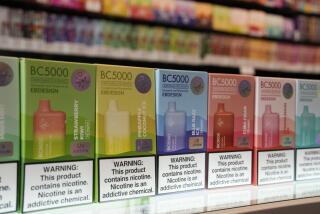Op-Ed: Let’s call this youth vaping crisis what it is: A Juuling epidemic
- Share via
Almost daily, educators across the country tell me that at least half of their students use e-cigarettes, mainly the Juul brand. Many of these young people show clear signs of addiction. They are agitated, emotional and unable to sit through an entire class period. They often need to leave class to “take a puff.”
National data about the pervasiveness of e-cigarettes show that it increased nearly 80% among high school students from 2017 to 2018. One in 5 report currently vaping.
But the vaping habit can start even earlier. Use among middle school students increased by almost 50% over the same time period, with 1 in 20 students reporting they had recently vaped.
Given that Juul Labs control about 70% of the e-cigarette market, allow me to borrow slang popular with teens and call this youth crisis what it is: A Juuling epidemic.
Vaping proponents would have you believe that e-cigarette use among youth is responsible for fewer of them smoking traditional cigarettes. This is simply not the case.
Statistics show significant declines in conventional cigarette use among youth from 1996 to 2016. But e-cigarettes weren’t sold in the U.S. until 2007, and Juul entered the U.S. market in 2015 as part of another company before becoming independent in 2017. The dramatic increase in youth vaping began that same year.
The e-cigarette industry has created this vaping epidemic among the young. It actively markets dangerous nicotine delivery devices to adolescents while trying to confuse the reality surrounding the use of these nicotine products.
The increase in e-cigarette use among young people has also been largely attributed to the youth-oriented flavors, misperceptions about nicotine levels and risk, and the patented and unique salt-based nicotine.
E-cigarettes are the entry point for adolescent tobacco use. The overwhelming majority of youth who use e-cigarettes have never smoked conventional cigarettes or used other forms of tobacco. As their need for nicotine increases, they are likely to incorporate conventional cigarettes into their routine.
Nicotine is highly addictive. Each Juul pod, which contains the nicotine liquid that is aerosolized and inhaled, has the same amount of nicotine as is found in one to two packs of cigarettes. And the changes occurring in the still-developing brains of youth make them especially susceptible to addiction.
Research also shows that the chemicals found in e-cigarettes and the flavors used in them are harmful and can result in heart and lung disease and be poisonous, among other health consequences. The products are so new the long-term consequences are unknown, a fact the CEO of Juul labs has admitted.
Vaping proponents also argue that the flavors in e-cigarettes play a role in helping adults switch from traditional cigarettes to e-cigarettes. However, studies have repeatedly shown that young people use e-cigarettes because of the flavors. If flavors didn’t exist, they say they wouldn’t vape.
Many of the more than 15,000 unique e-cigarette flavors have silly names, such as Honey Doo Doo, Booger Sugar and Barney Pebbles. Names that aren’t exactly aimed at an adult audience. Kids are also attracted to the mint and menthol flavors, long thought to be the purview of adults.
Cities and localities in California and at least five other states have restricted the sale of flavored tobacco products. In addition, the Food and Drug Administration and states including California and Hawaii have proposed statewide regulation to eliminate the sale of flavored cigars and flavored tobacco used in e-cigarettes and for hookah smoking. Unfortunately, mint and menthol are often exempted from these policies.
Juul continues to argue that its products are aimed at helping adults quit smoking. If executives at Juul, or any other e-cigarette company, truly viewed their products as “tobacco cessation aids,” they would try to help the user withdraw from nicotine by offering pods with increasingly lower nicotine levels, which could help them taper off use. No such products are offered. They also would apply to the FDA to obtain authorization to sell their products as a cessation device, rather than as a tobacco product. No such action has occurred.
Juul also claims that it is not targeting youth, but its actions say otherwise. During last month’s congressional hearings on Juul’s role in the youth vaping and nicotine epidemic, the company’s “prevention and education efforts” were shown to be an attempt to mislead and encourage youth to use its products.
Another concern is Juul’s recent hiring of Dr. Mark Rubinstein, an adolescent-medicine physician and prominent nicotine researcher I trained in tobacco control research. Rubinstein is known for his work on the dangers nicotine poses to the adolescent brain. Juul publicly says it hired Rubinstein to enhance its youth-vaping prevention efforts.
But given Juul’s history of deceptive marketing practices and educational efforts that promote rather than deter use, many in the research community are skeptical. Rubinstein, a specialist on the effects of nicotine in adolescents, is now working in an industry he recently took to task. His joining Juul is very surprising, disappointing and troubling.
E-cigarette companies seem to be following in the dishonest path of traditional cigarette companies by employing marketing that doesn’t accurately reflect the harm vaping can do. (Just last week, the FDA announced it was investigating 127 reports of seizures or other neurological symptoms possibly related to using e-cigarettes.)
The youth e-cigarette movement needs to be stopped. Doing so will require a complicated multistep process that should start with the FDA, states and local agencies enforcing strict policies that cut back on nicotine levels allowed in vaping pods, eliminate the sale of all e-cigarette flavors and ban marketing to youth.
Bonnie Halpern-Felsher is a professor of pediatrics at Stanford University and founder and executive director of the Tobacco Prevention Toolkit, an online curriculum that educates youth about tobacco products.
More to Read
A cure for the common opinion
Get thought-provoking perspectives with our weekly newsletter.
You may occasionally receive promotional content from the Los Angeles Times.










